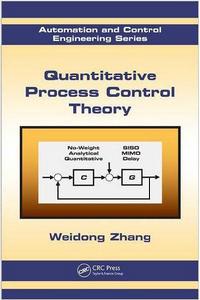內容簡介
Quantitative Process Control Theory一書介紹針對化工被控對象,如何使用新穎的控制系統設計理論進行分析與設計。書中提出的易於使用的理論不需要設計者選取權函式,但是可以根據定量的工程化的性能指標(如超調等)進行控制器設計與整定。
書中每一章,均有總結性的內容提要介紹介紹該章主要研究內容,也提供了足夠的習題用於提高和測試對於內容的掌握程度。對於絕大多數的理論結果都給出了數學證明,同時書中的例子取材於真實的化工過程場景,包括造紙過程、熱帶磨機、磁懸浮系統、核反應堆、蒸餾塔/重油分餾器、套管冷卻反應堆、飛彈、直升機/飛機和麻醉等。
書中的理論成果來自於作者近二十年的理論研究,對於解決單輸入單輸出(SISO)和多輸入多輸出(MIMO)控制系統的定量性能指標問題,提供了一種獨特且切實可行的設計方案。書中很多材料已經在套用於課堂教學,適合於工程學科高年級本科生、研究生、魯棒控制入門階段的研究者,以及想掌握新型控制設計方法的工程師。
作者簡介
張衛東,男,1967年生。上海交通大學自動化系教授,博士生導師,國家傑出青年科學基金獲得者, 德國洪堡學者,上海市優秀學科帶頭人。現任上海市最佳化與控制軟體工程研究中心主任、上海高校船舶自動化工程研究中心主任和上海交通大學自動化系副主任。長期從事控制理論及套用研究。在學術上提出了定量過程控制的學術思想, 相關成果已總結成英文專著在CRC Press出版; 發表SCI論文90篇, 論文被SCI他引459次,獲得國家發明專利授權26項;理論成果在造紙、發電、精密儀器和海洋工程等領域得到成功套用。榮獲全國高校霍英東優秀青年教師獎和2項省部級自然科學二等獎等12項獎勵, 培養的學生3次榮獲上海市優秀博士生學位論文。曾擔任以色列國家基金海外評審、國家創新人才計畫評審專家和國家科技獎勵評審專家。
本書特色
•對於諸如超調等工程實際中的性能指標提供了定量解決方案;
•對於SISO/MIMO時滯系統提供了解析設計方法;
•提出一種無權函式的最優控制設計方法,不需要使用複雜的數學工具;
•提供了一種高效快速地設計控制的方案;
•對與理論與套用均有所側重;
•為經典的控制理論與後發展起的魯棒控制理論建立起橋樑;
•書中涵蓋大量的有效的物理系統案例,提供具有差異化難度的習題。
該書曾榮獲2015年上海普通高校優秀教材獎、上海交通大學第十五屆優秀教材。
前言
Since the Industrial Revolution, control systems have played important roles in improving product quality, saving energy, reducing emissions, and relieving the drudgery of routine repetitive manual operations. In the past hundred years, many theories have been proposed for control system design. However, there are three main problems when some of these advanced control theories are applied to industrial systems:
1. These theories depend on empirical methods or trial-and-error methods in choosing weighting functions.
2. Both the design procedures and results are complicated for understanding and using.
3. The controllers cannot be designed or tuned for quantitative engineering performance indices (such as overshoot or stability margin).
In this book, an improved theory called the Quantitative Process Control Theory is introduced to solve these problems. This new theory has three features:
1. When using the theory, the designer is not required to choose a weighting function.
2. The design is suboptimal and analytical. It is easy to understand and use.
3. The controller can be designed or tuned for quantitative engineering performance indices.
These features enable the controller to be designed efficiently and quickly.
Mathematical proofs are provided in this book for almost all results, especially when they contribute to the understanding of the subjects presented. This will, I believe, enhance the educational value of this book. As few concepts as possible are introduced and as few mathematical tools as possible are employed, so as to make the book accessible. Examples are presented at strategic points to help readers understand the subjects discussed. Chapter summaries are included to highlight the main problems and results. At the end of each chapter, exercises are provided to test the reader’s ability to apply the theory he/she has studied. They are an integral part of the book. There is no doubt that a serious attempt to solve these exercises will greatly improve one’s understanding.
The methods developed here are not confined to process control. They areequally applicable to aeronautical, mechanical, and electrical engineering. To stress this point, examples with different backgrounds are adopted. With a few exceptions, these examples are based on real plants, including
· Paper-making machine · Heat exchanger · Hot strip mill · Maglev · Nuclear reactor · Distillation column/Heavy oil fractionator · Jacket-cooled reactor · Missile · Helicopter/Plane · Anesthesia
The book is divided into 14 chapters. Important topics that are coveredinclude
1.Introduction and review of classical analysis methods (Chapter 2)
2.Essentials of the robust control theory (Chapter 3)
3.H∞ and H2 proportional-integral-derivative controllers for stable plants with time delay (Chapters 4 and 5)
4.Quasi-H∞ and H2 controllers for stable plants with time delay (Chapter 6)
5.Quasi-H∞ and H2 controllers for integrating plants with time delay (Chapter 7)
6.Quasi-H∞ and H2 controllers for unstable plants with time delay (Chapter 8)
7.Complex control strategies, including two degrees-of-freedom control, cascade control, anti-windup control, and feedforward control (Chapter 9)
8.Analysis of multi-input/multi-output control systems (Chapter 10)
9.Classical multi-input/multi-output system design, including decentralized control and decoupling control (Chapter 11)
10.Quasi-H∞ decoupling control for plants with time delay (Chapter 12)
11.H2 optimal decoupling control for plants with time delay (Chapter 13)
12.Multivariable H2 optimal control (Chapter 14)
This book is intended for a wide variety of readers. It is appropriate forhigher level undergraduates and graduates in engineering, beginners in the research area of robust control, and engineers who want to learn new design techniques. It is assumed that readers have had an undergraduate course in classical control theory. A prior course on optimal control or process control would be helpful but is not a requirement.
This book has grown out of 15 years of research. The procedure is alwaysmuch harder than anyone anticipates. I received financial support from the National Science Foundation of China, the Alexander von Humboldt Foundation, Germany, and the National Science Fund for Distinguished Young Scholars, China, which enabled me to pursue the research. I am vastly indebted to many people who have helped and inspired me to start, continue, and complete this book.
My first thanks goes to Professor Shengxun Zhang and Professor YouxianSun, Zhejiang University. They brought me into the area of process control. I am grateful for the continuing help and support from Professor Xiaoming Xu, Professor Yugeng Xi, Professor Songjiao Shi, Professor Zuohua Tian, and Professor Xinping Guan at Shanghai Jiaotong University. I am also greatly indebted to Professor F. Allg¨ower and Professor C.A. Floudas, who hosted me at the University of Stuttgart and Princeton University, respectively, as a visiting professor during the writing of this book.
The first six chapters of this book have been classroom tested for severalyears at Shanghai Jiaotong University. Many students have contributed their time to the book. I would like to thank my PhD students F. S. Alc´antara Cano, Danying Gu, Daxiao Wang, and Mingming Ji for particularly helpful suggestions.
The book makes limited use of the material from several books. In particular, I want to express my sincere appreciation to Morari and Zafiriou (1989), Doyle et al. (1992), and Dorf and Bishop (2001).
Family members are a source of special encouragement in a job of thismagnitude, and I send love and thanks to my parents and my son in this regard.
Lastly, I thank my wife, Chen Lin. She read the manuscripts of differentversions and made corrections in her spare time. She gave hundreds of suggestions on editing, grammar, and technical problems. This book would not be the same without her enormous care and patience.

